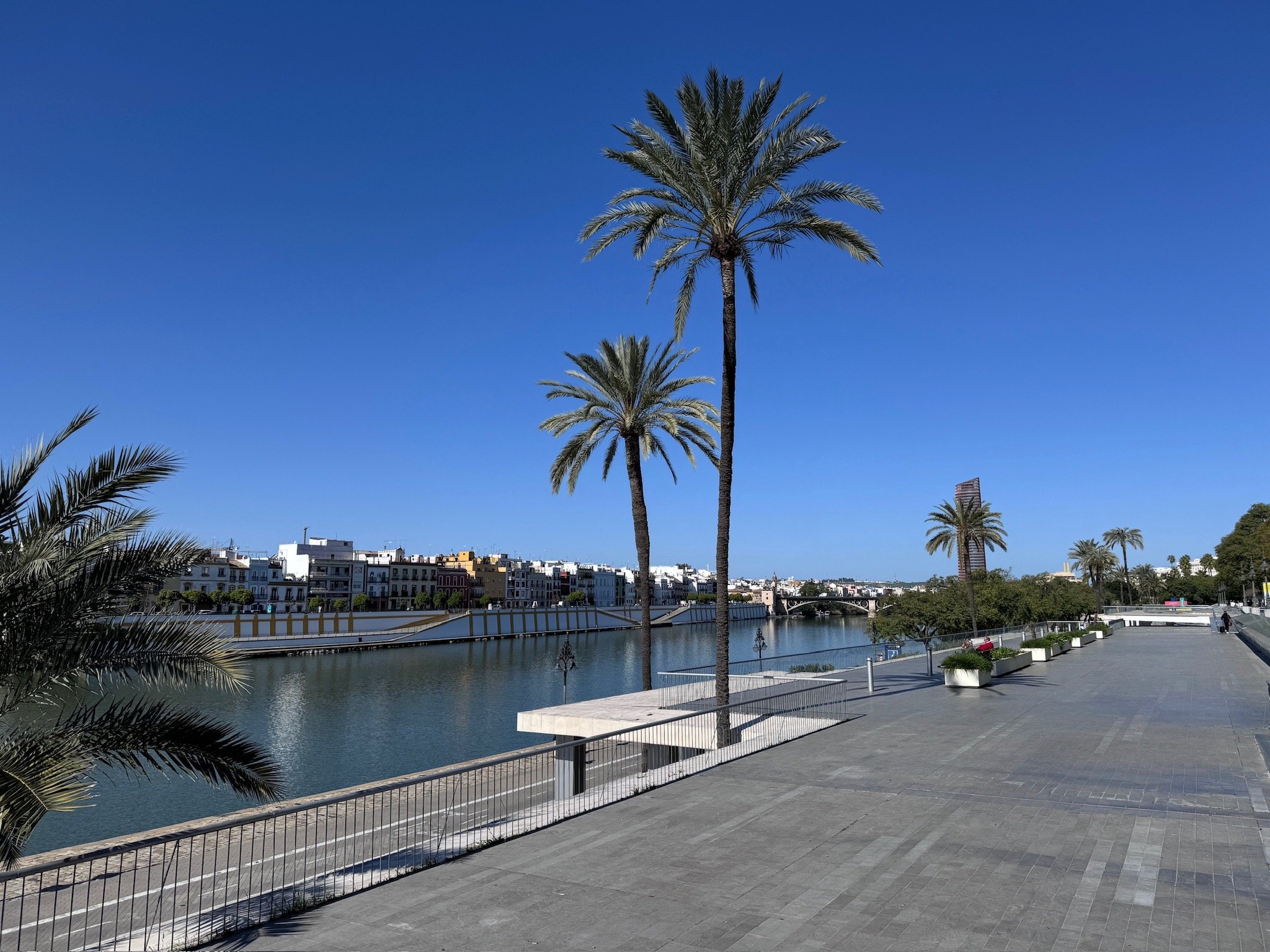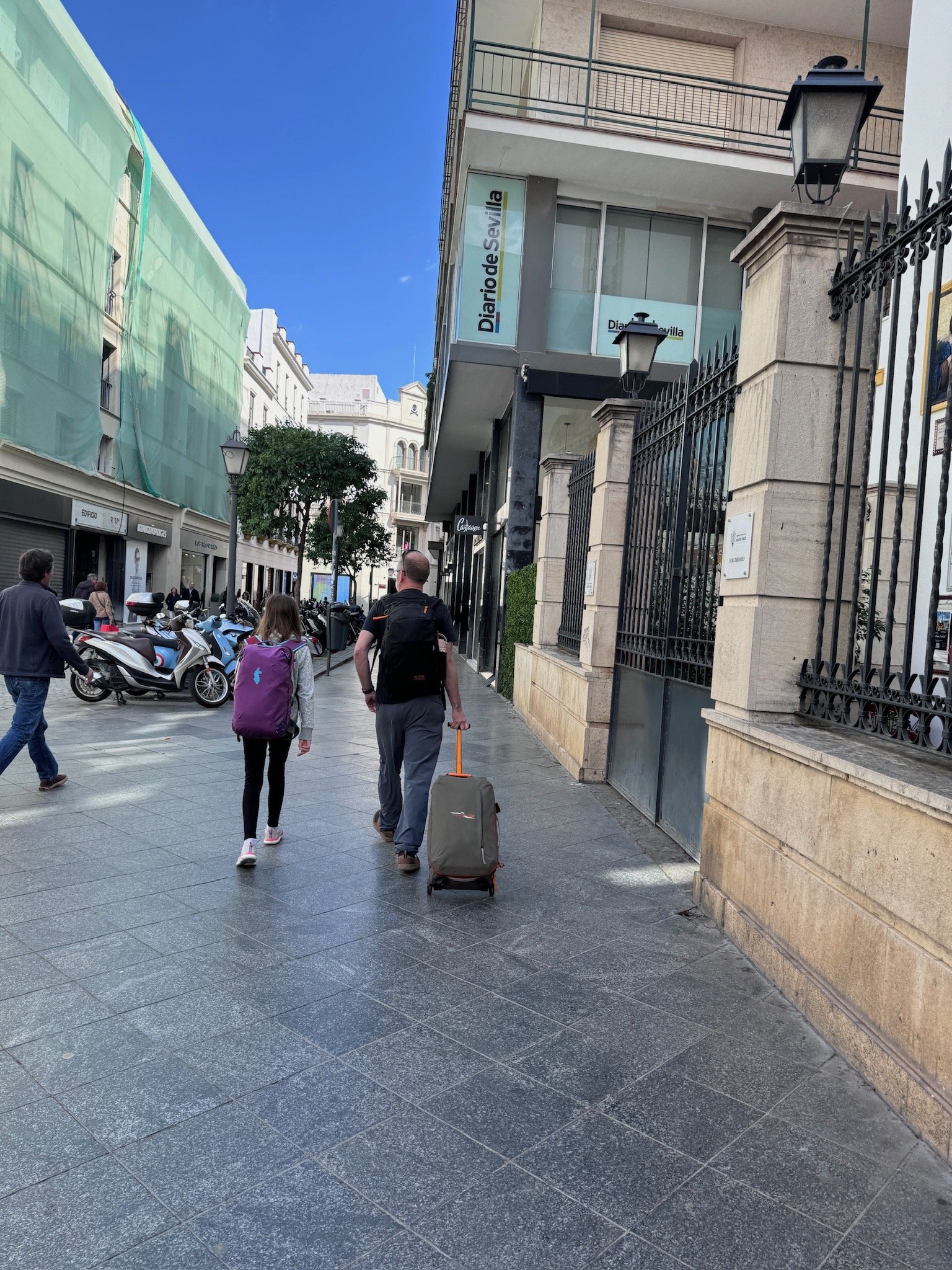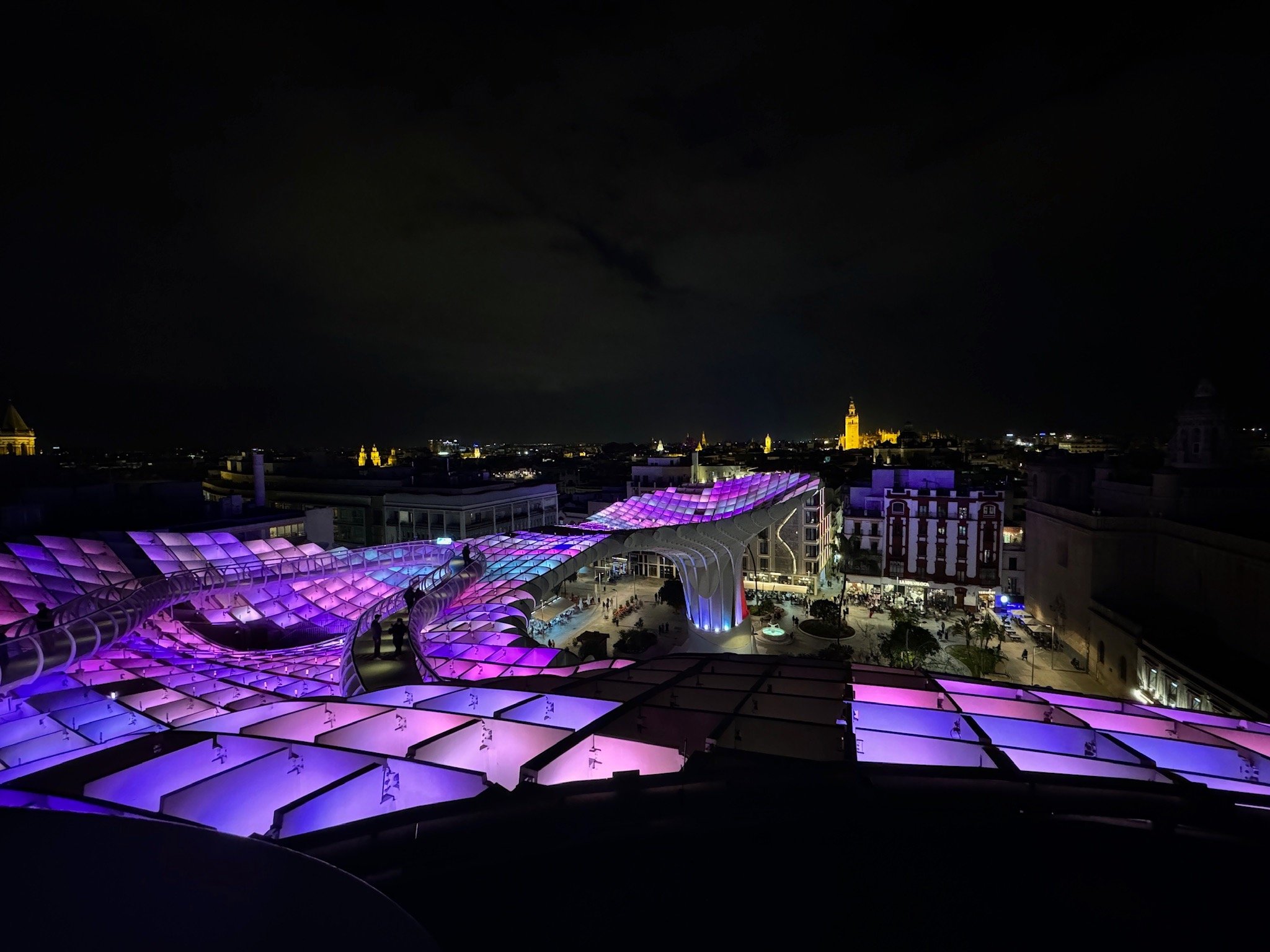Seville, Spain - Day 2

Friday, March 1, 2024
Today was our first full day in Seville, Spain. Surprisingly, we all slept well in our rented city apartment. I expected it to be noisy all hours of the night with people walking through the city streets, but we didn’t hear a thing. This apartment is well designed with the living room closer to the street, and the bedrooms further down a hallway. There’s also heavy doors that separate the living and sleeping areas of the apartment which keeps street sounds away from the bedrooms.
Andi made us a nice breakfast of eggs, spinach, mushrooms, and toast this morning at our airbnb before we set out to explore the city. The center of Seville is very walkable with most of the narrow streets for pedestrians only. Within minutes, I fell in love with this city. There’s so much color and detail in the narrow streets, tons of shops and restaurants with outdoor tables, and charming squares surrounded by historic buildings. More than that though, the city of Seville has a good energy about it. You can feel the life, the culture, and the history of the city simply walking through its streets.
This morning, we booked a private city walking tour through a company called With Locals. Andi and I like to sign up for a city tour when we arrive somewhere new because it helps us learn more about the place we’re visiting, and it gives us a solid lay of the land. Our tour guide, Juan Fernando, met us at 10:00am at the Plaza de Triunfo outside the Cathedral of Seville. When he introduced himself, he joked that Spanish moms like to give their sons two names at birth, just in case he loses one.
Juan Fred, as he called himself, started our tour with a brief explanation of the history of Seville. The city was originally ruled by the Phoenicians (descendants of the Canaanites), then the Romans in the 2nd century, the Vikings (of Nordic descent), the Moors (Muslims of North Africa and the Iberian peninsula) in the 7th-11th centuries, and finally the Christians (Catholics and Jews) in the 12th century. In total, people have been living in this city for over 2,000 years. Influences from each of these people groups is still seen in Seville’s architecture today.
We saw long lines cued outside the Cathedral of Seville and the Alcazar, Seville’s historic royal palace. Juan Fred said visitors need to buy tickets (in person or online) to enter those buildings, and the lines we saw today were nothing compared to how long they typically are during Seville’s high-season. Nevertheless, he recommended we buy tickets during our stay in Seville to see the insides of those historic buildings.
Also in the Plaza de Triunfo is the Archive of the Indies which houses important documents and maps from the Age of Discoveries, including papers from Christopher Columbus’ discovery of America. Christopher Columbus was born in Genoa, Italy but lived his adult life in Seville, Spain. The Spanish monarchy funded his quest to discover western trade routes to the Indies. A monument is dedicated to Christopher Columbus inside the Cathedral of Seville. Four figures, representing the providences of Spain at the time of Columbus’ death, hold up his tomb. How amazing is it that Christopher Columbus is buried here?!
As we walked around the exterior of the Cathedral, Juan Fred pointed to various historical aspects of the church, and shared information about each one. The beautiful Giralda Tower stands out at 103 meters (337 feet) tall. For many years, it was the tallest building in Seville. The tower was originally built as a minaret for the five-times-daily call to prayer when the Moors (Muslims) ruled Seville. Legend says the minaret was built with a long, winding ramp inside because the official who called the prayers was handicapped, so he got to the top of the tower on horseback.
When the Christians conquered the Moors of Seville in 1248, they built a gigantic cathedral (the 3rd largest in the world) directly on top of the existing mosque. Parts of the mosque were demolishing, but the Christians kept the beautiful minaret tower, the absolution fountain in the center courtyard, and some of the exterior walls. Today, examples of both religions are seen in the building’s architecture. At one of the entrances, for example, the metal doors and archway (dating back to the Moors in the 11th century) have an Arabic design. Christian religious figures were added to the sides of the archway when the Christians took over rule. I think it’s interesting that the Christians kept parts of the Moorish mosque. Perhaps they appreciated the beauty of the architecture, even though it was a different religion than their beliefs.
Andi and I both commented how grateful we are to have traveled through Morocco last month, as we’ve learned so much about the country’s cultural influences and design. I would have never noticed or appreciated the beautiful Arabic script on this door, or the three stairs that symbolize the way to heaven on the top of the exterior walls, had it not been for our experience in Morocco. Travel opens your eyes to the world, and gives you such a deeper appreciation for people, art, and history.
Because the Cathedral is a Catholic church, there are many symbols of Christianity displayed on the facade of the church today.
Semana Santa (Holy Week, the week before Easter) is quickly approaching, and there are lots of preparations underway in the city of Seville right now. Juan Fred said there are processions throughout the city during Holy Week, as well as masses held at the Cathedral and other Catholic churches. We’ve seen lots of flyers posted announcing the festivities.
On the Calle Alemanes side of the Cathedral, Juan Fred pointed out red graffiti markings on the building. Our guide told us that when he was a child, the exterior of the cathedral was a darker color. It wasn’t until about 10 years ago that the exterior of the building was expertly cleaned, and the markings were discovered. The red graffiti, written in animal blood, was drawn on the facade of the Cathedral during the Lower Roman Empire to announce the high achievement of becoming a doctor. The letters form the word “victor!” written alongside the person’s name. It’s incredible to think about these markings being hidden underneath soot on the cathedral walls for centuries, and makes you wonder what other parts of history remain hidden among the city?
Next, Juan Fred took our family to the Jewish Quarter of the city centre. When Ferdinand III of Castile conquered the city from the Moors in the 12th century, he forced all the Jewish people to live in this neighborhood. There used to be a gorgeous metal cross in the center of the orange trees, but someone vandalized it about five months ago, Juan Fred said. In its place, there is now a small red and white flower cross.
Juan Fred also talked about the bitter orange trees found in this courtyard and all throughout the city centre. He said these orange trees are a symbol of Seville to him, and the smell of their flowering each spring reminds him of his childhood. It’s thought that the Moors originally planted the orange trees in their courtyards to give off a fragrant perfume smell. Based on our experience in Morocco with all the different smells, I could see this to be true!
Not far from the cathedral, our tour guide led us to Plaza de Cabildo which features a semi-circular colonnade and part of the original Moorish wall of the city. This was a really peaceful courtyard to spend some time in, with a fountain in its center and palm trees growing around it. On Sundays, Juan Fred said there’s an antiques market that takes place here.
From the city centre, we walked in the direction of the Guadalquivir River. On the other side of the river is the Triana neighborhood, a working-class neighborhood known for its production of colorful tiles. There is a rich history of bull fighting and flamenco dancing as well.
Juan Fred pointed out the famous Plaza de Toro bull fighting arena. He told us there are only a handful of bull fights held in Sevilla every year during the Feria de Abril. I invoked a passionate speech from him when I asked if people still support bull fighting, or if they feel it is animal cruelty. Yes, the bulls are killed during the fight, he said, but they are treated far better than other livestock people raise and eat for meat. Bull fighters are also risking their lives in the fight. He said Spaniards like his grandfather are truly outraged when people question the integrity of bull fighting because the tradition is woven deep into their culture.
Near the Triana bridge, also known as the Puente de Isabel II, we said good-bye to Juan Fred and thanked him for his informational tour this morning. The four of us continued walking over the bridge to the Triana neighborhood to find something to eat for lunch. Juan Fred recommended the Triana Market, so we went there first.
Inside the Triana Market, there were lots of food stalls selling produce, tapas, and other handicrafts. We walked through the aisles, but didn’t find anything that particularly suited our family’s tastes. It was busy inside with only a few tables for eating, and the food didn’t look like something the kids would eat, or that Andi’s stomach would tolerate. Most people were drinking beer or wine and eating tapas.
At 11:30am, we were a little early in the day to be eating lunch — too early for the locals to eat, at least. Several restaurants were serving alcohol and tapas (little bites of food), but no actual meals until at least 12:30pm. We eventually found one restaurant with an open kitchen, and were seated on the outdoor patio with a bunch of other tourists eating an “early” lunch.
I let Andi order our food to ensure he got something that agreed with his sensitive stomach. He ordered grilled chicken served with french fries, a caesar salad, and paella with prawns. Restaurants in Spain always offer sliced bread or a small baguette with meals, and hard breadsticks that come in a bag. They only charge you for them if you eat them, which we inevitably do because we’re always starving by the time we sit down to eat. The bread and breadsticks are terrible though — so dry without butter or any dipping sauce — and every place is the same. I don’t understand the reason behind this.
After lunch, we walked along the main street of the Triana neighborhood filled with restaurants and stores. By now, patio tables were packed with people eating lunch on the sidewalk. It was a fun, upbeat atmosphere with street performers dancing between tables collecting tips. Tory wanted gelato, so Andi stopped at an ice cream store to let her pick out a flavor. Aden and I decided we wanted to find a churro stand for our treat.
From Triana, we started our 30-minute walk back to our airbnb. The sun was shining brightly and the air temperature warmed up to 65 degrees. It was a very nice afternoon, and it felt so good to be warm again! We happened to walk by a churro stand along the way, so we stopped to try this infamous Spanish treat. This was one of my “must try” foods while visiting Spain.
Aden and I went to the walk-up counter and ordered two churros with chocolate, not quite realizing how big they were. The worker handed me a paper bag filled with long, thick churros and two plastic cups of melted chocolate. The proper way to eat a churro in Spain is to dunk the fried dough into the cup of chocolate. It reminded me of a hot, fresh funnel cake (without the powdered sugar). It was delicious!
We also took a picture of Flat Will eating a churro for Aden’s friend Will’s class assignment.
Back at our airbnb apartment, Andi rested in the bedroom while Tory, Aden, and I did school in the living room. The kids also journaled about what they learned during our city walking tour.
Tonight, Andi arranged for our family to go to a flamenco performance in Seville. Flamenco culture originated in Andalusia, the province where Seville is located, and has since become a symbol of the Spanish culture. This particular show was recommended by our airbnb host as a show suitable to bring kids. I liked that the performances were early in the evening at 7:00 and 8:30pm.
We decided to eat an early dinner at our airbnb since we were going to the flamenco show tonight. While I finished school with the kids, Andi prepared skillet chicken, steamed carrots, potato wedges, and strawberries for us. We ate, and then walked about 10 minutes away to the theatre.
No photography was allowed inside the theatre, but Andi did snap a sneaky pic of Flat Will at the performance. The flamenco show was in a small, intimate theatre and was comprised of a singer, two dancers, a guitar player, and a drummer. The Spanish music was powerful. It was amazing to watch the flamenco dancers tell a story through clapping, stomping, costumes, and body movements.
After the show, the four of us slowly made our way back to our airbnb. The kids wanted to stop for treats again, so we agreed to let them pick something. Tory chose a slice of cake and Aden picked a scoop of ice cream from Ben & Jerry’s. We sat in a plaza courtyard on the staircase of a church and people-watched as the kids ate their desserts. The atmosphere was lively with people socializing and drinking outside restaurants and bars in the area.
Andi was hungry again, so he wanted to find a grocery store empanada stand he’d read about online. We navigated our way to a department store inside the city centre. Reviews online said the empanada stand was in the basement level of the shopping center, so we wandered all over trying to find it. “We’ve come too far, we can’t walk away now,” Andi said after we’d searched every floor. Eventually, he asked someone who worked behind a beauty counter, and she directed Andi to a set of elevators in the back corner of the department store. This bank of elevators led to the basement level, and to the empanada stand.
It was crazy how busy this department store / shopping area was at 10:00pm. I still can’t wrap my brain around two sets of business hours with a long siesta time in between. When do people sleep if they’re buying groceries at 10:00pm?
Andi found the empanada store and ordered two empanadas for himself. I figured I might as well order some, too, though I’m not sure why I felt the need to eat a second dinner right before bedtime. Tory was appalled why we’d want empanadas after eating so many of them in Argentina last year.
We got our empanadas to-go, and then made the 10-minute walk back to our airbnb apartment. The empanadas were very tasty. Andi saved the leftovers to have for breakfast tomorrow.
What a full and exciting day we had exploring the city of Seville. We learned and saw so much, I can’t wait to spend a few more days here soaking in the culture.

































